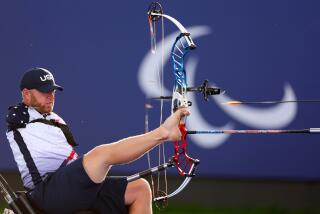Amputee Develops Inexpensive Prosthesis
- Share via
FAYETTEVILLE, N.C. — For his fifth birthday, Tommy Hilburn got new camouflage boots, just like the ones his stepfather wears as a soldier at Ft. Bragg.
Within a few days, Tommy was lacing up his boots by himself--no mean feat for a little boy with an artificial arm.
Tommy’s arm is a simple instrument, without the custom-fitted socket for residual limbs that’s found on standard prostheses.
That simplicity makes it correspondingly affordable--for people like Tommy and for those around the globe in more desperate circumstances, such as war and disaster.
“We can put an amputee in a limb in 15 minutes,” says Charles Holder, a triple amputee who invented what he calls the Socketless Mounting Platform.
Holder claims his artificial limbs should last up to 15 years, weigh half as much as their traditional counterparts and cost a fraction as much. Tommy’s mother, Chrissy Smith, relied on Medicaid until recently and says she would have been unable to buy him a conventional prosthesis.
Holder is trying to generate interest in his limbs for humanitarian medical missions in developing countries and for immediate postoperative use everywhere.
To promote their use, Holder has been selling them for about $300 apiece. He hopes eventually to sell his below-the-elbow prosthesis for about $1,200 retail and is designing above-the-elbow and leg devices that would cost a few hundred dollars more.
LeRoy Nattress, who heads the Amputee Information Exchange in San Bernardino, is among those spreading the word about Holder’s device.
“The thing I saw immediately was that this had application as an immediate post-surgical appliance for upper-extremity amputees,” says Nattress, a retired professor of family medicine at Loma Linda University and former executive director of the American Orthotics and Prosthetics Assn.
Holder, a Michigan native who moved to Fayetteville in 1994 with his wife, Ann, a chiropractor, lost his lower left arm in a wood-chipper accident in 1980.
That barely slowed him down, but two years later, Holder, a dealer and aficionado of exotic cars, suffered third-degree burns over much of his body when he crashed at a Wisconsin racetrack. Resulting circulatory problems eventually cost him both legs.
“I was driving my life really fast, and I crashed and burned,” he says. “Something was missing in my life, and what was missing was my relationship with God. When I got that, everything changed. . . . I began to find ways to serve others instead of serving myself.”
Holder, who began tinkering with prostheses about 10 years ago, has filed more than a dozen patents for his artificial limbs in the last year.
“My experience has equipped me uniquely to do what I do,” he says. “I understand it completely, as completely as anyone can.”
Holder, honored as North Carolina’s Disabled Citizen of the Year in 1997, points to the cost of his own conventional prosthetic legs-- $33,000--as a reason why inexpensive, easy-to-use prostheses are needed.
“When I lean my legs against my Jeep and think, ‘These legs cost $10,000 more than my Jeep,’ something’s wrong with this picture,” he says.
Last year a friend told him about Tommy, who’d lost his lower right arm in a lawn-mower accident when he was a year old. Holder gave the boy one of his below-the elbow devices.
“When he first got it, he had to sleep with it,” says Chrissy Smith. “I tell him he has a special hand from God.”
The shy, energetic youngster talks about his arm matter-of-factly, as if grasping and manipulating things with a hook controlled by a strap running across his shoulder blades is no big deal.
“It’s good,” Tommy says.
A small army of volunteers helps Holder make the simple devices from aircraft-grade aluminum normally used in the prosthetics industry for leg braces, as well as prosthetic plastic, steel cables, Velcro and screws.
“We just sit around the kitchen table and put limbs together,” he says.
Tom Rollo of Milwaukee uses Holder’s device as a backup to his conventional prosthetic arm.
“It’s something you can put on without having it to be professionally fitted,” says Rollo, who met Holder last year at a meeting of the Amputee Coalition of America and subsequently bought one of his arms.
“It’s not anatomically accurate in any way, shape or form, but it’s not meant to be, so you can do what you want with it,” Rollo says. “It’s something you can throw on if you want to wash the car.”
While his limbs are less cosmetically appealing than conventional prostheses, Holder says they can last for years because of the durable materials and because there are no sockets to wear out.
World Hope International, a relief organization based in Springfield, Va., has bought more than 300 of Holder’s artificial arms and distributed a number of them in Sierra Leone, where rebels have chopped off limbs and otherwise mutilated thousands of people in a nine-year civil war.
“One [recipient] went home and cooked dinner and cleaned fish,” says Jo Anne Lyon, World Hope’s executive director.
“It’s easy to deploy, it’s very durable, and it’s very comfortable,” says Kim Kargbo, manager of WHI’s Limbs of Hope program. “It’s a good limb for rapid deployment and for multiple-patient deployment.”
More to Read
Sign up for Essential California
The most important California stories and recommendations in your inbox every morning.
You may occasionally receive promotional content from the Los Angeles Times.













